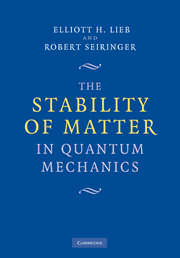Book contents
- Frontmatter
- Contents
- Preface
- 1 Prologue
- 2 Introduction to Elementary Quantum Mechanics and Stability of the First Kind
- 3 Many-Particle Systems and Stability of the Second Kind
- 4 Lieb–Thirring and Related Inequalities
- 5 Electrostatic Inequalities
- 6 An Estimation of the Indirect Part of the Coulomb Energy
- 7 Stability of Non-Relativistic Matter
- 8 Stability of Relativistic Matter
- 9 Magnetic Fields and the Pauli Operator
- 10 The Dirac Operator and the Brown–Ravenhall Model
- 11 Quantized Electromagnetic Fields and Stability of Matter
- 12 The Ionization Problem, and the Dependence of the Energy on N and M Separately
- 13 Gravitational Stability of White Dwarfs and Neutron Stars
- 14 The Thermodynamic Limit for Coulomb Systems
- List of Symbols
- Bibliography
- Index
11 - Quantized Electromagnetic Fields and Stability of Matter
Published online by Cambridge University Press: 20 December 2010
- Frontmatter
- Contents
- Preface
- 1 Prologue
- 2 Introduction to Elementary Quantum Mechanics and Stability of the First Kind
- 3 Many-Particle Systems and Stability of the Second Kind
- 4 Lieb–Thirring and Related Inequalities
- 5 Electrostatic Inequalities
- 6 An Estimation of the Indirect Part of the Coulomb Energy
- 7 Stability of Non-Relativistic Matter
- 8 Stability of Relativistic Matter
- 9 Magnetic Fields and the Pauli Operator
- 10 The Dirac Operator and the Brown–Ravenhall Model
- 11 Quantized Electromagnetic Fields and Stability of Matter
- 12 The Ionization Problem, and the Dependence of the Energy on N and M Separately
- 13 Gravitational Stability of White Dwarfs and Neutron Stars
- 14 The Thermodynamic Limit for Coulomb Systems
- List of Symbols
- Bibliography
- Index
Summary
So far we have treated the magnetic field B as a (classical) external field, with an energy We would now like to broaden our horizon and treat the electromagnetic field in its proper role as a dynamical quantity. Moreover, we would like to go even further and quantize this field in the canonical way, which will automatically give us the quantization of light, as discovered by Planck in 1900. The Hilbert space for this revised quantum mechanics will be larger than the L2 spaces considered before, and will involve Fock space. The stability of matter questions will become more complicated in some ways and will have to be revisited.
The ultimate version of quantum electrodynamics is even more complicated. The number of electrons is not fixed, but fluctuates. Electrons are defined by a quantized field and can be created and destroyed. We shall not venture into this realm, however, and will continue to regard the electron number N as fixed.
We begin with a review of electromagnetism, which the knowledgeable reader can safely skip. A good reference for further details is Spohn's treatise.
Review of Classical Electrodynamics and its Quantization
Maxwell's Equations
In classical electromagnetic theory, the interaction of charged particles is mediated by fields, which is to say (possibly time-dependent) functions on R3. There are six in fact, consisting of two (three component) vector fields E(x) and B(x), the electric field and the magnetic field. These satisfy the following equations, known as Maxwell's equations. With the notation ∂f (x, t)/∂t = f(x, t), they The two equations (11.1.1) are the inhomogeneous Maxwell equations and the two equations (11.1.2) are the homogeneous Maxwell equations.
- Type
- Chapter
- Information
- The Stability of Matter in Quantum Mechanics , pp. 200 - 220Publisher: Cambridge University PressPrint publication year: 2009

